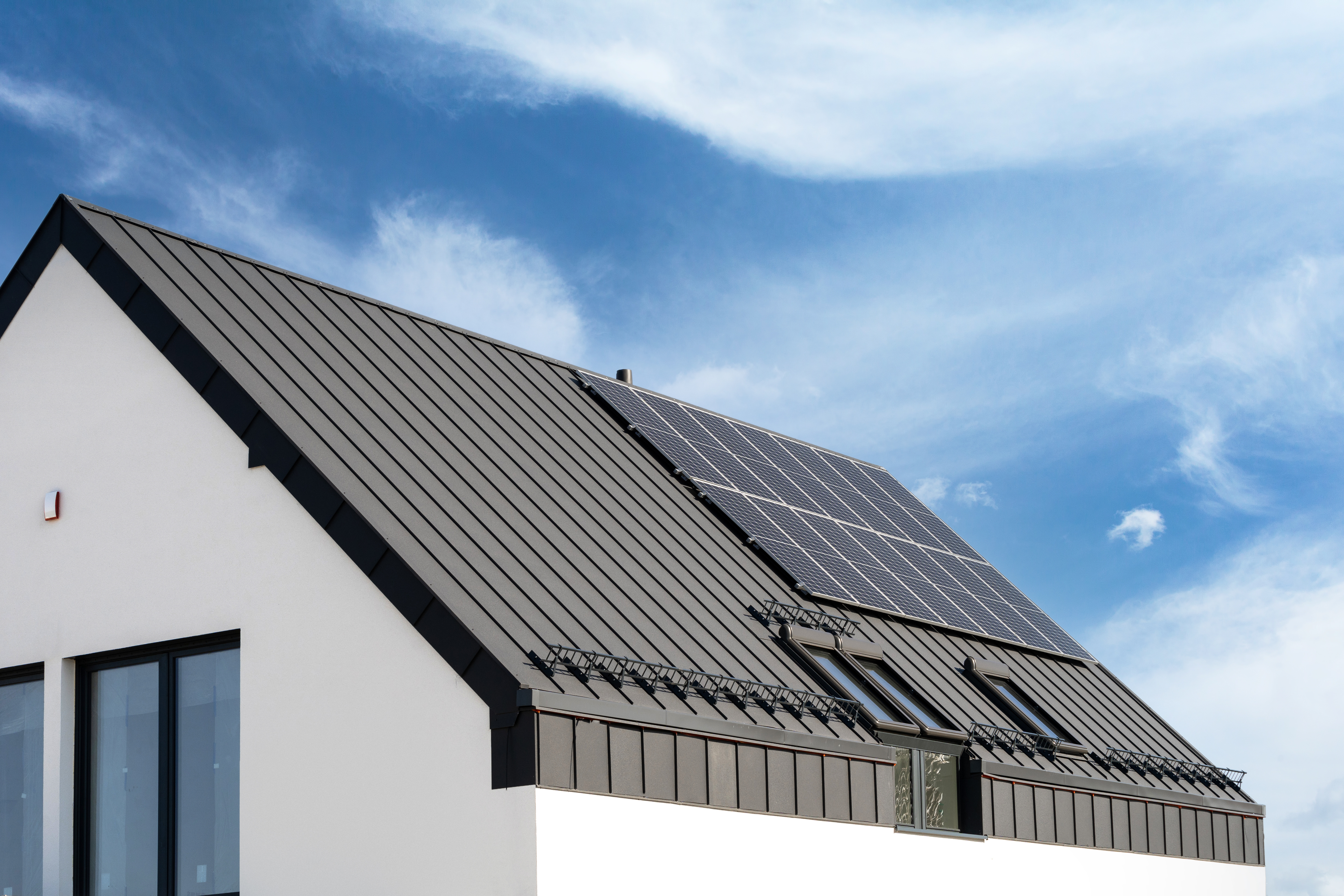
A metal roof can defend your home against Ohio’s varying weather conditions. Learn how much a metal roof costs in Columbus, OH.
Reinforce your roof’s defenses against inclement weather and gale-force winds


While a roofer will cost between $45 and $75 per hour to install hurricane ties, they have the experience and equipment to do the job quickly and correctly.
It’s a good idea to hire a professional for safety reasons, as working on a roof can be hazardous.
Professionals can ensure that the finished project is compliant with all local building codes.
While you’re hurricane-proofing your home, consider hiring a hurricane shutter pro to take care of your shutters.
High winds—like those experienced during a hurricane—can shake the bones of your home. Hurricane ties are steel connectors that reinforce your roof’s trusses by securing them to the wall framing. In the event of winds of 74 mph and higher, your roof has a better chance of staying secure and in place with hurricane ties. Learning how to install hurricane ties requires a bit of know-how around structural elements like roof trusses and beams, so read on to evaluate if you’re ready for the task.
Hurricane ties have many names, including hurricane clips, straps, or rafter and roof truss ties. These metal pieces have nail and screw holes made of stainless or galvanized steel. They add extra reinforcement to the areas where your roof framing meets your home, so if you ever experience severe weather, your roof is more likely to withstand the storm. Building codes in some areas require hurricane ties in new builds and reroofing projects.
The two main types of hurricane ties are single-sided and U-shaped, and both come in different models and shapes. Some models are made for wooden walls, while others are made for wood, concrete, and masonry walls. Also, hurricane tie models vary in size, so measuring your trusses and rafters correctly before buying your materials will save you time and money.
Here’s a quick rundown of the types of hurricane ties, their basic function, and which works best for what:
Single-sided hurricane ties: Single-sided ties reinforce the connection between the truss and the wall plate. You can install these in pairs or by themselves. Single-sided ties include models H2.5T, H2A, H8, H3, H2.5A, H6, and H7Z. Each has a slightly different shape and length and most are rated for moderate loads.
U-shaped hurricane ties: This type of tie can withstand uplift and downward forces. These are a common choice because of their ability to handle larger demand loads and they’re faster to install than two single-sided ties. Models H1A, H1.81Z, H10S, H14, H11Z, H10A, and HS24 are all U-shaped ties. Some models have longer bottom straps, while others are made for trusses and rafters at specific pitches.
Other ties: Hurricane gusset angles (HGA) have a 90-degree shape and connect the truss to the top plate. HPT hurricane ties, made for homes in Hawaii, connect rafters to the walls.

Before you begin, consider calling a structural engineer near you to inspect your roofing and assess the strength of the connection between the roof and wall plate. Based on your home’s physical location and the demand load, your structural engineer can recommend the type and number of roof ties to withstand potential hurricane forces. Hiring a structural engineer costs about $350 to $800.
If you decide to handle everything yourself, you’ll want to take measurements and make notes. For one, your trusses will have a capacity rating in pounds, so you need to get hurricane ties that can handle that capacity. Depending on your roof, you may need to install multiple hurricane ties for one rafter or truss to meet the capacity requirement.
Some things to look for that may indicate you should opt for emergency tarping or roof repair include missing or damaged shingles, interior water leaks, visible damage to the components of the roof, or signs of large debris, like tree branches, on your roof.
Learning how to hurricane-proof your home with hurricane ties can help you protect your home from the force of extreme weather. Here are the four steps you need to follow.
Each connection will need its own hurricane tie for reinforcement. Specifically, you’re looking for spots where the diagonal truss meets a horizontal beam running to the roof. The hurricane tie will be fitted to these two pieces of wood, creating a continuous load path.
The hurricane tie may come with specific instructions for positioning the tie. For example, if you’re using a U-shaped tie, you’ll want to place it around the rafter or truss and against the wall plate. Ties should be located at connection points as well as between the joists and the top plate (e.g., the horizontal beam on top of the walls).

The hurricane tie may also include special fasteners. If not, you may want to choose a structural screw or ten-nail for securing the tie. Make sure to utilize all the holes provided to maximize reinforcement and secure the tie flush against the wall plate.
Ensure all of the screws or nails are firmly in place and nothing is wobbly or rickety. A series of well-installed ties is your roof’s best defense against uplift forces.

Since hurricane ties are a structural project located and installed near your roof’s joists, a roofer near you can help with this project. Roof labor costs range from $45 to $75 per hour, which doesn’t include the cost of materials. When all is said and done, this is likely a full-day project for a roofing contractor. You’ll pay more if more ties are needed or connections are more challenging to access while retrofitting your home.
D1 Roofing delivers outstanding service from beginning to end, backed by a strong warranty and expert teams. I highly recommend them for their excellence in meeting and surpassing expectations with unmatched communication. Choosing D1 Roofing was flawless decision
I am really impressed with their timeliness and turnaround. Mitchell came out, and we decided to move forward with their pricing. Our roof was on within a week, and we could not be happier with their team! Amazing company, great prices and honest, dependable craftsmanship. I highly recommend...
We used Unique Hardwood Floor LLC three years ago to work on the floors of a 70 year old home that needed a great deal of work. Some floors needed repairs, some were replaced and others just needed to be refinished. It was a complicated job as they needed to blend the old and the new to...
While Naaman and Mike were very professional and amicable to work with, there were issues in this project that makes giving a higher rating impossible. We had several communications issues that delayed completion. The roofers accessed the property without communicating with me. Just showed up...
Lyle did a great job removing asbestos shingles from our front porch roof. They worked together with our roofer to make sure that the new roof was able to be installed on the same day that Lyle removed the asbestos shingles.
Several years ago Pomante replaced the roof of a small area of my house, the porch roof, with a rubber roof. This is a shallow roof and shingles were never able to shed the water appropriately; I needed a rubber roof. At that time they were the only company I could find that would do this...
From average costs to expert advice, get all the answers you need to get your job done.

A metal roof can defend your home against Ohio’s varying weather conditions. Learn how much a metal roof costs in Columbus, OH.

Learn about roof replacement costs in Columbus and what factors are at play to budget accurately and make sure you’re getting a fair price.

Dealing with a visibly damaged roof or leak? Learn about roof repair costs in Columbus to see how much you’ll need to budget for a permanent solution.

If you need a new flat roof, learn about tar and gravel roof costs and what can affect your total to make sure you budget accurately.

Furring strips support your metal roof and improve ventilation, but only if spaced correctly. Here’s the ideal spacing of furring strips for metal roofs.

An attic without proper ventilation can cause a number of roofing problems, inside and out. Here’s how you can tell if a poorly ventilated attic is wrecking your roof.